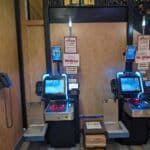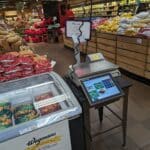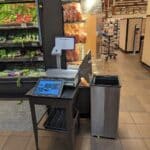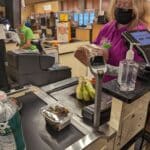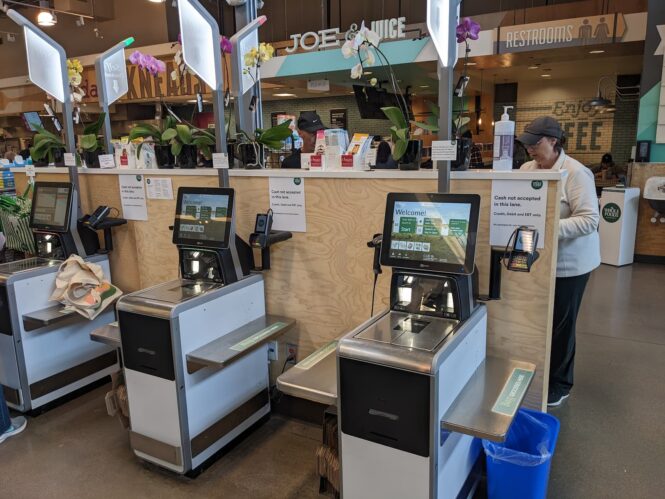
Self-Checkout Is NOT a Failed Experiment
Editors Note 12/25 – be sure and visit our page on Walmart Self-Checkout. Latest RFID cart checkout similiar to Wegmans being tested.
A commentary by Craig Keefner — Periodically, a “burst” of editorial articles blasting self-checkout appears in the news. We are coming up on Christmas, so no big surprise. Generally, the “headlines” are catchy and play up consumers’ dissatisfaction with retail. In SEO circles, we call it clickbait, and it does, in fact, attract clicks and eyeballs, which ultimately convert into advertiser dollars. The more clickbait, the more that publication is cash-strapped, is one theory. If we sold advertising we would probably do it for that matter. Revenue is the ultimate factor.
We call it pandering to a demographic with objective being clicks. Not much we can do about it.
In her recent article, “Self-Checkout Is a Failed Experiment,” Amanda Mull argues that self-checkout is a failed experiment that is both inconvenient for customers and unprofitable for retailers. She cites a number of reasons for this, including:
- Self-checkout kiosks are often unreliable and require frequent assistance from employees.
- Self-checkout can be time-consuming and frustrating, especially for customers with large baskets or complex items.
- Self-checkout leads to increased theft and shrinkage.
- Self-checkout has eliminated many jobs and contributed to the decline of customer service.
While I agree that self-checkout has some flaws, I believe it is too early to call it a failed experiment. Self-checkout technology is still relatively new, and it is constantly improving. Additionally, many retailers are taking steps to address the concerns that Mull raises.
For example, some retailers are installing new self-checkout kiosks that are more reliable and easier to use. Others are offering more assistance to customers who need it, and they are taking steps to reduce theft.
The latest Walmart “ditches” bioptic scanners and is going Lidar and cameras in the footsteps of Amazon Just Walk Out technology.
A quick rebuttal of the “points” in the Atlantic article
- Generally, you never wait in line. It actually beats C-Stores in this regard (which is eager competitor we should add)
- Setting a purchase down always goes on the right. To be purchased on left. No problems there.
- Scanning is rarely a crapshoot. There is some problematic packaging for sure but rare
- An employee is usually called in for coupons (which is a process that deserves to be less paper oriented)
- Employees are not mean to customers.
- Alcohol purchase at Costco does require 10 secs of age validation (blame the laws not the retailer)
- Walmart has not removed “kiosks entirely. That’s poor writing by someone more familiar with style.
- Costco has same number of staffers and its SCO process is exemplary. The best of both worlds combined into one.
- Employee count at stores with SCO has gone up and then you need to include all the high paid technical support staff maintaining the machines.
- Apparently, it is tough times at publications and they can no longer afford competent informative writers. I am considering NOT renewing my subscription. Being a sales clerk at Bestbuy does not qualify someone as retail analyst.
- SCO is being blamed for a litany of situations including unstocked shelves, even lower wages (Kroger pays $18/hour to start), stores are messier.
- Word usage: doom loop, messier, rotted, harder, shoplifting, suspicious,spike. Their audio report was produced by ElevenLabs and NOA, News Over Audio, using AI narration. Quite the human touch for someone against machine automation.
- If you really want to know what the store is charging you for a product, go thru the SCOs.
Self-checkout also has a number of advantages over traditional checkout lines. For example, self-checkout can help to reduce wait times and improve customer satisfaction. Additionally, self-checkout can give customers more control over their shopping experience.
Here are some of the specific advantages of self-checkout:
- Reduced wait times: Self-checkout can help to reduce wait times for customers, especially during peak shopping hours. This is because customers can scan their own items and pay at their own pace.
- Improved customer satisfaction: Studies have shown that customers are generally satisfied with self-checkout. This is because self-checkout gives customers more control over their shopping experience and allows them to avoid long checkout lines.
- Increased customer throughput: Self-checkout can help retailers to increase customer throughput. This is because self-checkout kiosks can process transactions more quickly than traditional checkout lanes.
- Reduced labor costs: Self-checkout can help retailers to reduce labor costs. This is because self-checkout kiosks can be operated by fewer employees than traditional checkout lanes.
Of course, self-checkout is not perfect. However, I believe that it has the potential to be a valuable tool for both customers and retailers. As the technology continues to improve and retailers learn to implement it more effectively, self-checkout is likely to become even more popular and successful.
Here are some suggestions for how retailers can improve the self-checkout experience for customers:
- Install reliable and easy-to-use self-checkout kiosks.
- Offer more assistance to customers who need it.
- Take steps to reduce theft.
- Educate customers on how to use self-checkout kiosks effectively.
- Provide incentives for customers to use self-checkout kiosks.
By following these suggestions, retailers can make self-checkout a more convenient and positive experience for customers.
We should note that as far as technology goes, the writer seems to excel at fashion writing and “all things stylish”. She is out of her depth here. All of the “issues” she points to are more opinionated fluff, and not facts. I can go down the line with them. There are drawbacks to SCO but she doesn’t bother to talk about those.
Another article “Why Costco’s Self-Checkout System Leaves A Lot To Be Desired”
I shop at Costco and many other stores that use SCO machines (Whole Foods, Krogers, Kohls, etc). Personally the Costco SCO option is by far the BEST.
- The writer seems to think you need two forms of identification. I simply use my Costco card (has a picture on back).10 secs.
- Hand scanners raised his ire. Fact is any customer coming thru with bulky items automatically get a real person assistant who does all your scanning for you. It’s great and superfast.
Apparently, that is all this writer (not sure who he is) could only come up with two false negatives for his Costco clickbait article.
Drawbacks to Self-Check Out of SCO
Self-checkout is not without issues and you can see that in new iterations being tested by Walmart and others. Some of the major players like NCR are struggling at best and unlikely to revolutionize retail anymore. But new players are emerging to take their place.
- One of the biggest problems are customers. Let’s be honest theft for whatever reason isn’t going down. SCO presents opportunities.
- In Krogers, the assisting help does double duty as security guards.
- In Krogers/e.g. improper balancing of SCO to Clerked Lanes results in backups at SCO.
- Produce is its own set of problems. Weight is a variable to deal with now. Is it organic or not?
- Accessibility – there are few considerations made for accessibility. Service for one is supposed to be service for all (or at very least most)
- Those motorized carts with the big baskets? They are a problem in SCO hubs.
- Packaging and barcodes are still not 100%. Go down to Walmart and buy a sealed package of Swiss cheese. The flap probably covers the bar code or its “scrunched” to unreadable.
- Privacy — watch a person in a wheelchair enter their PIN for their debit card
- Ambient Noise levels from all the audio
- The bartering of coupon codes could be radically improved. Little square pieces of paper tucked under a drawer and requiring human interaction. Stores should have coupon stations which allow everybody to utilize digital specials and “bank” those coupons for automatic use at the SCO machine.\
- Retail generally is always trying to save a dollar. When was the last time your bank put in new technology?
- Employees – while it is true that SCO reduces the need for direct response employees (clerks) they also increase thruput and volume to offset that. And having visited Bentonville and the service headquarters for Walmart I can tell you there are a ton of new jobs (higher paying) in supporting technology. Electronic/computer techs make a lot more than a checkout lane clerk.
Self-Checkout Statistics
- 85% of shoppers have used self-checkout
- Market value is $3.5 Billion ($7.3B by 2027)
- Retail self-checkout CAGR is 10%
- Over 40% of shoppers prefer self-checkout
- 67% of millennials like them
- 60% of customers prefer store that offers SCOs
- Walmart has 4.7 SCOs for every 10K of sq feet in stores
- The use of self-checkout systems has become increasingly popular in recent years, with 73% of consumers preferring them over staffed checkout lines. This preference is especially strong among Gen Z shoppers, 85% of whom opt for self-checkouts when available.
Real Life Example of SCO iterations at Wegmans
Wegmans is highly respected grocer and “smart” . They have a super high loyalty factor and as such can actually charge more for the experience. On a recent trip to Kodak Moments we had the opportunity to visit one of their flagship stores located in Pittsford, NY
- Mitigating produce problem at self-checkout
- Mitigating produce problem at self-checkout
- You attach to cart and just place the items in the cart. At the end a clerk helps with payment
- The self-checkout station in the store stands beside shelves stocked with snacks like gums, mints, and candy bars. A touchscreen invites you to Get Started, while a card payment terminal awaits your swipe and bags are ready for your purchased goodies.
- standard checkout lane
Articles (Pandering for the most part)
- Mull – Self-Checkout Is a Failed Experiment – The Atlantic
- Cotter — Why Costco Self-Checkouts Leave a lot to be desired — The Daily Meal
- Supermarket chain ditches self-checkouts and goes back to staffed tills – Sky.com
- UK shoppers: how do you feel about self-checkouts? – The Guardian
- Booths supermarkets to ditch self-checkouts — The Guardian
- A Grocery Chain Just Fired Its Self-Checkouts – The New York Times
- Popular Grocery Chain Removing Nearly All Self-Checkouts: “We … – MSN
- Is self-checkout worth it? The pros and cons for retailers, shoppers
- A grocery chain is removing self-checkout: ‘We like to talk … – Fortune
- Will Self-Checkout Ever Win Over Its Critics? – RetailWire
- The Road Ahead: Are self-checkouts a barrier to innovation?
- Must-Know Self Checkout Statistics [Latest Report] • Gitnux
